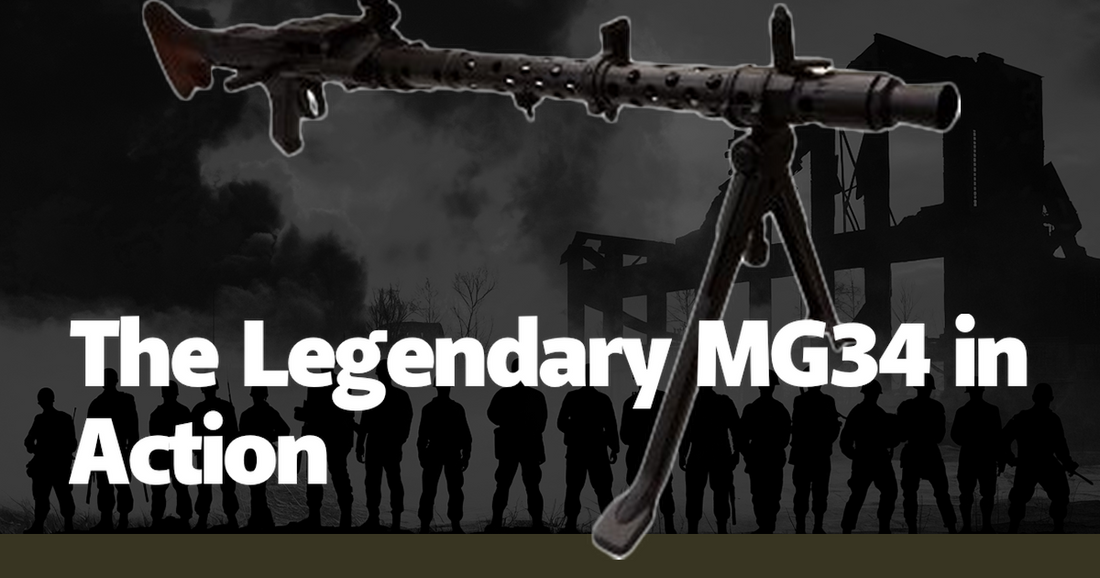The MG34, often heralded as the first modern general-purpose machine gun, stands as a testament to German engineering during the interwar period. Conceived by Heinrich Vollmer and introduced in 1934, this weapon was revolutionary in its versatility and reliability. The MG34 could be employed in various roles, from a light machine gun on a bipod to a heavy machine gun on a tripod, and even as an anti-aircraft weapon. This adaptability made it a formidable tool in the hands of the Wehrmacht, capable of laying down a withering hail of bullets that could suppress enemy forces and dominate the battlefield.
One of the most striking features of the MG34 was its rate of fire. With a cyclic rate of up to 900 rounds per minute, it could unleash a torrent of lead that was both intimidating and lethal. This high rate of fire was facilitated by its recoil-operated mechanism, which allowed for rapid cycling of rounds. Despite this, the MG34 was also remarkably accurate for a machine gun, thanks to its precision engineering and well-designed sights. This combination of speed and precision made it a favorite among German soldiers, who could rely on it to deliver devastating firepower in both offensive and defensive operations.
The MG34 saw extensive action during World War II, from the deserts of North Africa to the frozen steppes of the Eastern Front. In the hands of Rommel's Afrika Korps, it became a symbol of German tactical prowess. Anecdotes from veterans often highlight the MG34's role in key battles, such as the Siege of Tobruk, where its suppressive fire allowed German infantry to advance against well-entrenched Allied positions. Its ability to quickly switch from a bipod to a tripod mount meant that it could provide both mobile support and sustained fire, adapting to the fluid dynamics of desert warfare.
On the Eastern Front, the MG34's reliability was put to the test in the harshest of conditions. The brutal winters and muddy springs wreaked havoc on lesser weapons, but the MG34's robust construction and meticulous maintenance procedures kept it operational. Stories from the Battle of Stalingrad recount how German machine gunners, entrenched in the ruins of the city, used the MG34 to devastating effect, mowing down waves of Soviet soldiers in the close-quarters combat that defined the battle. Its ability to maintain a high rate of fire without overheating was crucial in these prolonged engagements.
The MG34's impact was not limited to its immediate tactical advantages. Its design influenced subsequent generations of machine guns, including the MG42, which would go on to become even more famous. The MG34's quick-change barrel system, for instance, was a feature that was carried over and improved upon in the MG42. This innovation allowed gunners to replace an overheated barrel in seconds, ensuring that the weapon could continue firing without interruption. This feature was particularly valuable in prolonged engagements, where continuous fire was necessary to keep enemy forces pinned down.
Despite its many advantages, the MG34 was not without its drawbacks. Its complex design made it expensive and time-consuming to produce, a significant issue for a Germany that was increasingly strained by the demands of total war. Additionally, its precision engineering, while contributing to its accuracy and reliability, also made it more susceptible to damage from dirt and debris. This was a notable disadvantage in the gritty, chaotic conditions of the battlefield. Nevertheless, the MG34's strengths far outweighed its weaknesses, and it remained a staple of German infantry units throughout the war.
The legacy of the MG34 extends beyond its service in World War II. It set a standard for what a general-purpose machine gun could be, influencing military doctrine and weapon design for decades to come. Post-war, many nations studied the MG34 and incorporated its features into their own designs. The Swiss MG51, for example, was heavily based on the MG34, and even modern machine guns owe a debt to its pioneering design. The MG34's blend of versatility, firepower, and reliability established a benchmark that has rarely been surpassed.
In conclusion, the MG34 was more than just a weapon; it was a game-changer on the battlefield. Its introduction marked a significant evolution in military technology, providing German forces with a tool that could adapt to a wide range of combat scenarios. From the deserts of North Africa to the urban ruins of Stalingrad, the MG34 proved its worth time and again, earning a place in the annals of military history. Its design innovations and battlefield performance have left an enduring legacy, cementing its status as a legendary firearm.

